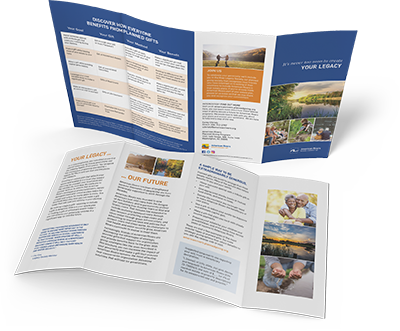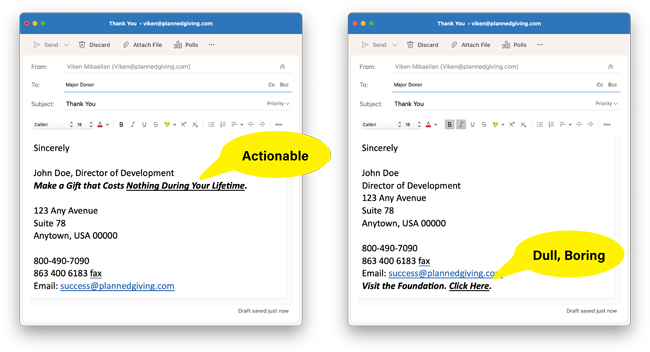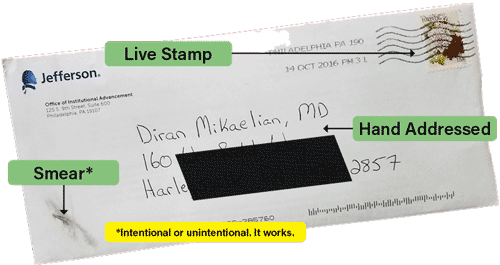- Ask your uncle’s opinion (unless he is a marketing expert)
- Ask an attorney to edit it
- Ask a professor to rewrite it
- Ask your staff’s opinion
- Ask more people to get involved
All this makes it more vanilla; the goal here is to tease, not appease.
/ˈbôriNG/
Solicitation letters can get boring, too. But they don’t have to. Use a freelance writer with a fresh eye. Those with advertorial experience are best. Our lead guy is Patrick O’Donnell, and he is available for help.
(Download a before-and-after sample.)

Your boss is shouting “budget, budget, budget” and pushing you to use electronic communications for your outreach. Save paper and stamps, he says. We once received an annual report that asked the reader to go online to download a list of donors who supported the organization. Pooh. Let the reader go online and download P&L statements and fancy financial bar charts, but donor names should come in print. One of our clients, a school in Dallas, begins their donor list on the cover of its magazine. Not on page 82 in 8-point type — on the cover!
Educate your boss with these pointers:
- Promoting planned gifts via digital outreach is not as cost-effective as people think. It has to be done right. And “done right” means more than pressing a send button.
- Along with digital outreach, you need a planned giving website with landing pages that collect information and feed it to a database. This costs money.
- On your planned giving website landing pages, you need an offer. Give them something in return for their information or for making a request. My Alma Mater used to send personalized stationery, for example.
- To do it right, you need a planned giving website vendor who knows A/B split testing (and maybe even A/B/C split testing, depending on your list size).
- Your first broadcast should be to a small group to analyze responses. Then, rethink your approach.
- Before doing anything, make sure the analytics for your planned giving website are in place.
- Test, test, test, and proofread. We have seen emails go out with: “Dear …”
- Learn about spam controls. Several innocent words could send your message into the spam folder, never to be seen.
- Hire a planned giving partner like us. Again, it’s more than just pressing a send button.
- Are you regulated heavily? Be careful. Although not heavily enforced, there are anti-spam rules you need to abide by, such as opt-ins, etc.
- Digital outreach should only be part of an integrated, multi-channel planned giving marketing solution. It’s not a good stand-alone tool. We can’t emphasize this enough.
You’ve followed what others are doing: gift planning direct mail, postcards and solicitation letters. But you know there are other venues you should tap into, but just can’t think of any. Here are some ideas. Perhaps not all will be suitable for your organization, but this is a good start:
- Local small papers. Call them. Often they are in need of stories as they run out of things to publish. Make sure to present an interesting angle on what you do. Don’t say “Our nonprofit helps children stay out of trouble.” Say, “Local businesses support our nonprofit by giving gifts of stock because they know that our current generation will be their future employees.” Need help developing content? Visit GiftPlanning.org.
- Local larger papers. Again, follow the advice in #1, but you may need a gift planning marketing partner. And it helps to place a display ad in the paper or magazine. One of our clients, Pomona College, advertises in the Wall Street Journal for charitable gift annuities. Maybe you’re not there yet, but could advertise bequests in your regional paper. Keep your eyes open. This practice works well for universities and colleges. If you decide to develop the display ad yourself, first learn the logistics and anatomy of display advertisements.
- Short internal video clips. This practice does not work for all, but is popular with retirement communities and animal shelters since they tend to have their own closed-circuit TV shows and internal communication. If your audience is “there,” and it’s easy for you to be there at no cost, be there.
- Write to NPR. The station loves to talk about other nonprofits. In fact, if you educate yourself on planned giving topics, you could be asked to educate its constituency about gifts of life insurance or lifetime income gifts. The station realizes your knowledge may eventually help its fundraising as well.

Say you have been doing bequest marketing heavily, and people start requesting information. They need your formal name … bequest language … even the address! And you have nothing to send out. The solution to your bequest marketing (or any planned giving marketing) challenge is easy. Here are a few suggestions:
- Order quick, easy-to-produce, off-the-shelf planned giving brochures. You do not need award-winning, beautifully designed publications here. Just simple pieces with your name, your logo and your colors. Work with a gift planning marketing partner. In fact, you can get planned giving brochures today.
- Estate Planning Brochures. Considering more than 68% of Americans do not have an estate plan, our estate planning brochures are great leave-behind pieces.
- Cornerstone Brochures. These are for sophisticated programs and for those “special donors.”
Whether you are marketing remainder trusts and unitrusts or simple beneficiary designations, consider having a planned giving website. And make sure the link to your web pages is obvious and easy to find for your donors. Your prospects need to understand that a deferred gift annuity helps them save for retirement and support your mission. Or that a charitable bargain sale is the only gift planning tool that gives you a lump sum of cash and a charitable tax deduction. Or whether to even consider gifts of real estate as a smart move for their situation.
You’ve tried to create a planned giving website yourself and discovered it looks lame compared to other nonprofit sites. You wonder why? It’s the difference between getting your car washed and getting it detailed. It’s the difference between an off-the-rack shirt and one that’s tailored. It’s the difference between an apple pie from the grocery store and the one your grandma made.
Then you realize the websites you like were created by a planned giving website partner such as PlannedGiving.Com, and you think that you can’t afford it.
Think again, and look at our Planned Giving Micro Website for the small charity. With a rush fee you can even have one delivered within days, still for significantly less than you think.
We provide customized planned giving websites that speak to prospects. Yes, we work with the Harvards of the world and deliver high-end products. But we also specialize in helping smaller shops and deliver exceptional affordable products as well.
Because our mission is to support you and your mission. Whether you are a large university, a private school, a hospital or healthcare system, an animal shelter or a zoo, we can create an appropriate, affordable planned giving website that meets your needs.
If you are still hesitating to move forward with a planned giving website, at least place our video files on your giving pages. You can get these files here.
9. Linking to Your Online PresenceYou have a planned giving website. Great. But you have no visitors.
It’s amazing how a small handful of nonprofits complain that no one is visiting their planned giving website. It’s like calling your local phone company and complaining that no one is calling you. Imagine if your boss says, “We just got this great phone system, but no one is calling us! We need to get a better system.” Sounds silly, doesn’t it?
Don’t be one of them!
Phone systems are taken for granted as they have been around for 100 years. Planned giving websites are much newer (we were the first in 1998). But they work the same way. You need to:
- Market your planned giving website with print and electronic mail.
- Have the URL in every internal resource, gift planning brochure, bequest marketing material and any publication you have promoting planned gifts.
- Have an elevator pitch and a link in as many planned gift marketing resources as possible. For elevator pitches see our Pocket Guide.
- Have donor stories linking to your website. Tell how “Judy” met her personal planning goals and supported your mission by creating a charitable remainder trust. Or how a pooled income fund worked for “William” by delivering him lifetime income. Or how “Elizabeth” has established multiple grants through her donor-advised fund. Make sure you have emotional stories like this one.
- Have display ads linking to it.
Sound like a lot of work? Not really. The good news is that once all of the above is done, it will all be on autopilot. Are you a small shop? We can help. Consider Legacy Giving in a Box – it covers all of this and more.
10. Ground Presence and VoicemailThis is a simple, esoteric tip, so we kept it for last.
You have a small nonprofit with a lot of foot traffic and zero budget. This applies to only a handful of nonprofits, so feel free to skip this step if that’s not you. Examples include retirement communities (lunch room), churches, gathering places, museums, and some healthcare facilities.
We’ve already covered what you can do with zero budget. Now, here’s a simple, powerful tool for a handful of nonprofits that is proven to work. It’s so simple, so cheap and so “mindless” that it is easy to overlook. Assume you are a retirement community. You have a dining room, possibly a few.
Invest $75 at Staples and create a nice-sized easel with a nice-sized, foam-core sign with large type that reads:
- Make a Gift and Receive a Guaranteed Paycheck for Life.
- Do you have CDs earning 0.7% interest? We can give you up to 8%.
Do not clutter the signs with disclaimers and qualifiers as attorneys recommend. That’s a downhill slope. Just whet people’s appetites. You can discuss the details later.
People, especially seniors, love receiving a guaranteed paycheck for life. Many establish multiple charitable gift annuities.
Whether you are teaching your prospects about bequests, gifts of life insurance or gifts of stock, simple marketing like this can attract interest and lead you toward closing a planned gift.
How About Your Voicemail?
A friend of ours at St. Mary’s University had a voicemail that goes, “Hi, this is Mike. To leave a message, press the # key. Did you know you can make a difference at St. Mary’s with a gift that costs nothing during your lifetime? Here’s how it works …”
11. Your Cash Giving PagesYour cash giving page must have a check box titled “Please send me more information on …” Consider another check box “I have left [name of organization] in my estate plans.” This download illustrates it best.
Furthermore, after one donates using a credit card, the donor should be directed to a Thank You page that presents more opportunities and explains what planned gifts are. Such details are covered in our marketing consultation services.
Have a creative solution yourself? Contact us. We’ll even publish your idea in Giving Tomorrow, our monthly magazine.
Share With Your Board:
#12: Bonus Tip: Your Signature Line

Signature lines are boring. Don’t make them worse. Note how the signature line is prominent on the left with an elevator pitch. Get your message across first, not your address. Your donor knows your address.
A typical email signature line such as “Visit us at the Foundation” will never get clicked. So use our ideas to develop compelling email signature lines and make sure everyone in your office uses them in their email correspondence. Place these lines (we call them “elevator pitches”) between your name and address, not way below your address. Have each line link to a specific page on your planned giving website. Get creative with these lines and have some fun: Make a gift that costs nothing during your lifetime; Giving stock could be more beneficial than giving cash; You can donate your home, get a deduction, and continue to live there for life; Make a gift and receive guaranteed income for life.
Resources for this Page
- Share With Your Board: The importance of planned giving.
- Have your own creative solution? Contact us. We’ll even publish your idea in Giving Tomorrow, our monthly magazine.
- Whether you’re brand new to the planned giving field or you’re a seasoned pro, we recommend you also read How to Launch a Planned Giving Program: 21 Steps, by Viken Mikaelian. It’s packed full of actionable ideas, valuable information, and planned giving marketing trends that will help you launch or refresh a powerful gift planning program.
- If you wish to learn how the different gift vehicles work, click here to read brief descriptions of each gift vehicle. Each writeup includes helpful explainer videos and typical donor profiles.
- Get a copy of our Planned Giving Pocket Guide or subscribe to The Planned Giving Wiki (free for clients). See the video What is Planned Giving to learn how planned gifts work, as well as some of the challenges your peers are facing (survey) right now.
- Download 12 Ways of Gifting.
- Download 75 Social Media Planned Giving Posts
Did This Envelope Get Opened?

An actual piece sent to my dad.
- Handwritten
- Live stamp
- “Dirty smear” on the envelope
- Stamp slightly on an angle
Everything says it was done by hand. Of course it got opened. And read. Clever.
Exactly what we profess.
Making Estate Planning Accessible, Simple, Personal, Secure and FREE!
Bequests are up, cash is down. Empower your donors to plan their will and invest their legacy in the cause they support the most.